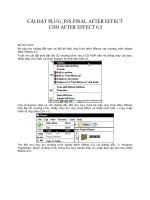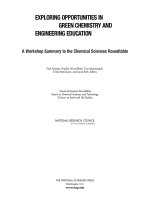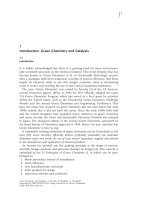Green chemistry final after film
Bạn đang xem bản rút gọn của tài liệu. Xem và tải ngay bản đầy đủ của tài liệu tại đây (528.52 KB, 25 trang )
Green Chemistry
Sponsored by:
“ Chemistry has an important role to
play in achieving a sustainable
civilization on earth.”
— Dr. Terry Collins, Professor of Chemistry
Carnegie Mellon University
Definition
Green chemistry is the design of products and
processes reducing or eliminating hazardous
substances.
Green Chemistry is a subset of Design for
Environment applying innovative scientific
solutions to product manufacturing.
Definition: An Industry Example
Shaw’s Green Chemistry Goals
Develop a sustainable thermopolymer
platform for the future.
Cradle to cradle sustainability of face
fiber and backing—100% of the product.
No increase in price. No sacrifice of
performance. No loss of design variety.
GREEN CHEMISTRY SUPPORTS
SUSTAINABILITY BY:
• Making chemicals safe for our health &
environment,
• Using industrial processes that reduce or
eliminate hazardous chemicals, &
• Designing more efficient
processes that minimize
waste
GREEN CHEMISTRY
MEANS…
• Preventing pollution before it happens
rather than cleaning up the mess later.
• Saving companies money by using less energy
and fewer/safer chemicals, thus reducing costs
& impacts of pollution.
• Mitigating climate change, water & resource
depletion, & growing demands for safer food
and cleaner energy
Green Chemistry Principles
1. Prevention: it is best to prevent pollution/waste
2. Atom Economy: synthetic methods should
maximize the incorporation of all materials
used in the process into the final product
3. Less Hazardous Chemical Syntheses: synthetic
methods should use and generate non toxic
substances
Green Chemistry Principles 4,5,6
4. Designing Safer Chemicals: products should be
nontoxic & designed to effect their desired
function
5. Safer Solvents and Auxiliaries: auxiliary
substances (e.g., solvents, separation agents)
should be avoided and innocuous when used
6. Design for Energy Efficiency: Run chemical
reactions at ambient temperature and pressure
Green Chemistry Principles 7,8
7. Use of Renewable Feedstocks: raw material or
feedstock should be renewable rather than
depleting
8. Reduce Derivatives: Avoid unnecessary
derivatization (use of blocking groups,
protection/deprotection, temporary
modification of physical/chemical processes)
because such steps require additional reagents
and can generate waste
Green Chemistry Principles 9,10
9. Catalysis: Catalytic reagents (as selective as
possible) are superior to stoichiometric reagents
which are used in excess and work only once
10. Design for Degradation: Chemical products
should be designed so that at the end of their
function they break down into innocuous
degradation products
Green Chemistry Principles 11,12
11. Analyze in real time to prevent pollution:
Include in-process real-time monitoring and
control during syntheses to minimize or
eliminate byproducts
12. Minimize accidents: Design chemicals and
their forms (solid, liquid, gas) to minimize the
potential for chemical accidents, releases,
explosions, and fires
Presidential
Green
Chemistry
Award
Recognizing Product Excellence:
Presidential Green Chemistry Award Recipient
Shaw EcoWorx™ Carpet Tile
Sustainable thermoplastic platform for the
future.
Closed-loop recovery of
face yarn and all backing
components.
No increase in price and
no loss of performance or
variety.
/>
Shaw Industries is the world’s largest
manufacturer of carpets for home and
business – and leader in sustainability.
TetraAmidoMacrocyclic Ligand
or TAML® Activators
Y
n–
O
N
X
N
X
III
Fe
N
O
R
N
O R
O
2. Oxidize catalyst until
cup “breaks”
1.
Design
molecular “cup”
thought to be
suitable for
attaining longlived catalysts
The Design
Protocol
That Led to
TAML®
Catalysts
3.
Characterize
broken cup
and identify
breaking
point
4. Modify weak site
to be more robust
Designing Ligands for Oxidizing Complexes, T. J. Collins A ccounts Chem. Res., 1994, 27, 279-285.
TAML® Oxidant Activators: A New Approach to the Activation of H2O2 for Environmentally
Significant Problems, T. J. Collins A ccounts Chem. Res., 2002, 35, 782-790
TAML® Catalyst Features
• formed from biochemically common elements
– prototype exhibits v. low toxicity
• beginning of “dial-a-lifetime” catalysis
• economical to synthesize
• water-soluble
• usable from pH 1 to 13
• efficient users of peroxide
—fast peroxidase/slow catalase
• 10 US patents, >70 counting foreign nationalizations
• effective at 0.1 to 4 ppm = nM to low µM
• amenable to modifications for capturing novel selectivity
• currently being produced for small scale commercial uses
TAML® Activators Are
Broadly Useful Oxidation
Catalysts
TEXTILES
dye bleaching,
effluent decolorization
PULP AND PAPER
pulp bleaching,
effluent AOX and color removal
WATER CLEANING
halogenated aromatics and
organics destruction
LAUNDRY
Dye transfer inhibition,
stain removal
plus
PETROLEUM REFINING
rapid oxidation of sulfur
contaminants, other uses
CHEM/BIO DEFENSE
Rapid destruction of chem-bio
Recognizing Product Excellence:
Presidential Green Chemistry Award Recipient
Shaw EcoWorx Carpet
PVC & polyurethane
substitute for carpet
backing
Made from nontoxic
polyolefin
Recyclable & contains
fewer harmful
chemicals
/>stry/dsca03.html
EcoWorx™ Production
Production ($)
80,000,000
Production (SY)
60,000,000
4000000
40,000,000
3000000
Production ($)
2000000
20,000,000
Production (SY)
1000000
0
0
1998 2000
1999
1999
2000
2001
2001
2002 20022003
EcoWorx represented 70% of all carpet tile
production at Shaw by the end of 2003
In June 2004 Shaw announced it would exit PVC use by year-end
in favor of the EcoWorx sustainable metallacene catalyzed
polyolefin compound.
Backing Chemistry
•LDPE - flexible base
polymer
•HDPE/MAH adhesion and filler
compatibility
•Alaphatic tackifier adhesion and flow
modification
•Coal Fly Ash –
inorganic filler
•Oil – adhesive
compatibilizer
EcoWorx™
Carpet Tile
Grinding and
airflow
separate
backing from
fiber for
sustainable
recycling
Fiber Chemistry
•Nylon 6 – caprolactam monomer
•25% postindustrial
recycled content
•Over 20 million lbs
of recovered nylon
used in 2003
•N6 depolymerization
by Honey-well
•recovered
caprolactam
repolymerized
IN SUMMARY,
GREEN CHEMISTRY IS…
• Scientifically sound
• Cost effective &
• Leads toward a sustainable civilization
For further information on real world green
chemistry
/>DOC=education\greenchem\cases.html
For introductory readings in green chemistry
http://www/chemistry.org/portal/a/c/s/1/
acsdisplay.html?DOC=education\greenchem\greenreader.html
Thanks to the Sponsors:









